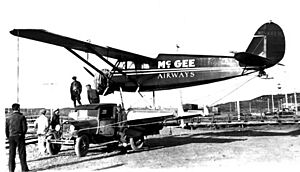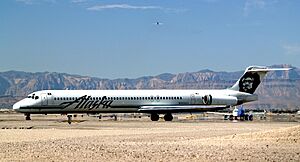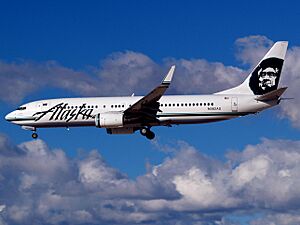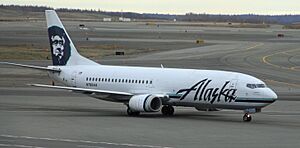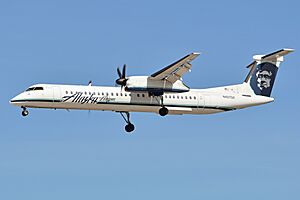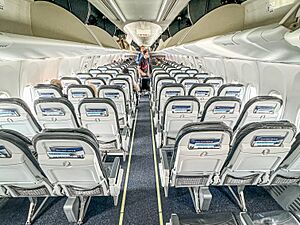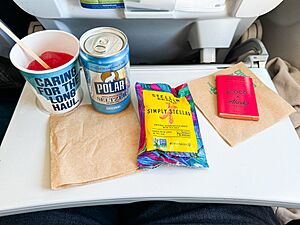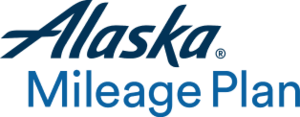Alaska Airlines facts for kids
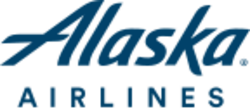
An Alaska Airlines Boeing 737 MAX 9
|
|
| Founded | April 14, 1932, as McGee Airways |
|---|---|
| Commenced operations | June 6, 1944 |
| AOC # | ASAA802A |
| Hubs |
|
| Focus cities |
|
| Frequent-flyer program | Mileage Plan |
| Alliance | Oneworld |
| Fleet size | 328 |
| Destinations | 128 |
| Parent company | Alaska Air Group |
| Headquarters | SeaTac, Washington, United States |
| Key people | Ben Minicucci (CEO) |
| Revenue | |
| Net income | |
| Total assets | |
| Employees | |
Alaska Airlines is a major American airline. Its main office is in SeaTac, Washington, near Seattle. As of 2024, it is the fifth-largest airline in North America based on how many passengers it carries.
Alaska Airlines, along with its partners Horizon Air and SkyWest Airlines, flies mostly along the West Coast of the United States. This includes flights to Alaska and Hawaii. They also fly to over 100 places in the contiguous United States, the Bahamas, Belize, Canada, Costa Rica, Guatemala, and Mexico.
The airline uses six main airports as its "hubs," with its biggest one at Seattle–Tacoma International Airport. Alaska Airlines is part of Oneworld, which is the third-largest group of airlines in the world. In 2024, the company that owns Alaska Airlines, Alaska Air Group, bought Hawaiian Airlines.
Contents
History of Alaska Airlines
Starting Out (1932–1945)
Alaska Airlines began as McGee Airways in 1932. It was started by Linious "Mac" McGee. The first flights were between Anchorage and Bristol Bay. Flights happened when people, cargo, or mail needed to be moved.
The airline faced money problems during the Great Depression. There were too many airlines in Anchorage, but not enough customers. Because of this, McGee Airways joined with other airlines. In 1934, McGee sold his airline to Star Air Service, another airline in Anchorage. Star Air Service was a big airline in Alaska with 15 planes.
In 1937, McGee returned to the airline. Star Air Service bought Alaska Interior Airlines and became Star Air Lines. In 1938, the government started regulating airlines. Star Air Lines got most of the routes it wanted in Alaska.
In 1941, Raymond Marshall bought Star Air Service. In 1942, the airline bought three more airlines in Alaska. Its name was changed to Alaska Star Airlines that same year.
During World War II, Alaska Airlines had few pilots and not enough money or equipment. Pilots often had to pay for fuel themselves. The company also had many different leaders. In 1943, Alaska Airlines bought its first multi-engine plane, the Lockheed Model 18 Lodestar. The company's stock was traded for the first time that year.
The name Alaska Airlines was officially chosen on May 2, 1944. In the 1940s, the airline's main office was in Anchorage.
Growing After World War II (1945–1949)
In 1945, Alaska Airlines hired its first flight attendants. In 1947, James Wooten became the airline's president. He worked to make the company bigger. The airline bought many extra military planes from the government that were used in World War II. These included Douglas DC-3s, Douglas DC-4s, and Curtiss-Wright C-46 Commandos. Alaska Airlines was the first airline allowed to fly DC-3s with skis.
Alaska Airlines made money from its large charter business. It moved its main operations to Paine Field in Everett, Washington. However, this worldwide charter business did not last long. In 1949, the government made rules stricter and fined the airline. This stopped the charter service because of safety issues, and James Wooten left the company.
In 1949, Alaska Airlines helped with Operation Magic Carpet. This was an effort to fly Jewish people from Yemen to Israel. C-46 or DC-4 planes were used for the long flights. About 49,000 people were flown by Alaska Airlines and other carriers without anyone getting hurt.
New Leaders (1950s)
Alaska Airlines started the 1950s without its worldwide charter business. Its flights were only within Alaska. In 1950, it bought two smaller Alaskan airlines.
In 1951, the government made Raymond Marshall leave the company due to money problems. That same year, Alaska Airlines was allowed to fly routes from Anchorage and Fairbanks to Seattle and Portland. This became a permanent permission in 1957.
In 1952, Nelson David became president. He helped the airline become financially stable. By 1957, Charles Willis Jr. became the new president and CEO. Willis, a pilot from World War II, brought in new ideas. Alaska Airlines was the first to show movies during flights. The airline also started using the Douglas DC-6, its first plane with a pressurized cabin. This allowed flights above clouds. On these DC-6s, they offered "Golden Nugget" service, which included a saloon and a piano.
The Jet Age (1960s)
In 1961, other airlines started using jets. To keep up, Alaska Airlines bought a Convair 880 jetliner. They used it for flights between Alaska and the rest of the United States. In 1966, the company got its first Boeing 727-100 jets. They stopped using the Convair 880. Some of Alaska's first 727s could carry both passengers and cargo.
In 1967, Alaska bought a Convair 990 jetliner. They also added more Boeing 727-100s. Later, they got longer Boeing 727-200s. Alaska Airlines was the first to fly the Lockheed L-100 Hercules. This cargo plane was used to move oil drilling equipment in Alaska and Ecuador.
Alaska also used Lockheed Constellation propeller planes. Smaller propeller and turboprop planes were also used. These included the Convair 240 and de Havilland Canada DHC-6 Twin Otter. They also had Catalina and Grumman Goose amphibian aircraft (planes that can land on water). These water planes joined the fleet when Alaska bought Alaska Coastal Airlines in 1968.
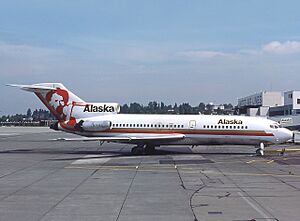
Alaska Airlines faced strong competition from other airlines like Northwest Airlines and Pan Am. To stand out, Alaska Airlines used fun ideas. They had safety instructions read as rhymes and even played bingo games on board.
In 1965, Alaska Airlines gave some routes and smaller planes to Wien Air Alaska. This allowed Alaska to focus on busier routes and sell off its smaller aircraft.
Throughout the 1960s, Alaska Airlines worked to bring more tourists to Alaska. They offered special flights to the continental United States. In 1967, Alaska Airlines expanded to southeast Alaska. They started flying to Sitka. This led to buying two smaller airlines, Alaska Coastal Airlines and Cordova Airlines, in 1968.
Tough Times (1970s)
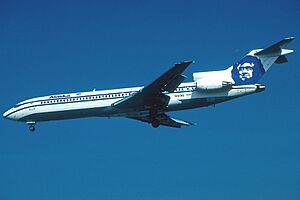
In the early 1970s, Alaska Airlines started Boeing 707 charter flights to Siberia in the Soviet Union. This was after three years of secret talks. Alaska Airlines also flew Boeing 707, Boeing 720, and Boeing 720B jets on regular passenger flights between Alaska and Seattle.
Like many airlines, Alaska Airlines was hit by rising fuel costs. It was close to going bankrupt. Also, money coming in dropped when work on the Trans-Alaska Pipeline System was delayed. The airline's cargo planes, which helped build the pipeline, were now sitting idle. On September 4, 1971, an Alaska Airlines Boeing 727-100 crashed while landing in Juneau. All 111 people on board died.
Because of these problems, the airline's board removed president and CEO Charles Willis. Ronald Cosgrave took over. The airline was $22 million in debt. Cosgrave made big cuts. The cargo business was stopped, and many flights and employees were cut. Cosgrave also worked to improve the airline's image. The logo was changed to a smiling Inuk man. As a result, the airline started making a profit again in 1973.
Growing After Deregulation (1978–1990)
Alaska Airlines was one of the few U.S. airlines that supported the 1978 Airline Deregulation Act. They knew it would help them grow. After deregulation, the airline's real estate part became its own company. Bruce Kennedy took over as the airline's leader.
When deregulation happened, Alaska Airlines flew to ten cities in Alaska and only one in the main U.S. (Seattle). It had only ten planes. Right after deregulation, the airline started adding new cities. These included Portland and San Francisco. Soon after, they added Nome and Kotzebue in Alaska, and Palm Springs, California. By 1985, the airline also flew to Oakland and San Jose in California. They also added Spokane in Washington, Boise in Idaho, and Phoenix and Tucson in Arizona.
Deregulation also brought challenges. The airline faced more competition and rising costs. By 1979, other airlines were flying larger jets on the busy Anchorage–Seattle route. There were also problems with unions. In 1985, the company had a three-month strike with its mechanics. By promising to lower labor costs, they ended the strike. In November 1985, the airline started a daily air-freight service called Gold Streak.
In the 1980s, Alaska Airlines started buying McDonnell Douglas MD-80s to replace its older 727s. Alaska was the first airline to use the MD-83.
Also in 1985, the Alaska Air Group was formed. This company became the parent of Alaska Airlines. In 1986, Alaska Air Group bought Horizon Air, which remained a separate airline. In 1987, Alaska Airlines bought Jet America Airlines. Jet America's flights were later combined with Alaska's.
To balance flights, the airline started flying to Mexican resort cities. Most people travel there in the winter. In 1988, the airline began flying to Mazatlán and Puerto Vallarta. By the end of the 1980s, 70 percent of Alaska Airlines' passengers flew south of Seattle. The airline served 30 cities in 6 states outside Alaska.
New Competition, New Technology (1990s)
In the early 1990s, the airline planned to lease 24 Boeing 737-400s. The first one arrived in April 1992.
In 1991, Alaska Airlines added new routes. They flew to Magadan and Khabarovsk in the Russian Far East. They also started service to Toronto, Canada. Toronto was later stopped in 1992, and the Russian flights ended in 1998.
After 19 years of making profits, Bruce Kennedy retired in May 1991. Raymond J. Vecci took his place.
During this time, Alaska Airlines faced more competition from low-cost carriers like MarkAir. MarkAir offered cheaper flights on the Anchorage-Seattle route. For the first time in 20 years, Alaska Airlines lost money.
To save money, the airline canceled plans for new maintenance buildings. They also delayed a large plane purchase. These cost cuts helped the airline make a profit again in 1994.
Alaska faced more competition in 1993 when Southwest Airlines entered the Pacific Northwest. Alaska Airlines worked to keep its costs low but still offered great customer service. The airline promoted itself as "the last great airline." However, there were many strikes by flight attendants. Vecci was replaced by John Kelly in 1995. The airline then expanded its West Coast routes.
Alaska continued to get new MD-83 planes in the 1990s. These planes helped meet the needs of a growing route system. They also replaced older, less fuel-efficient 727s. The last 727 was retired in March 1994.
Alaska Airlines was a leader in new technologies in the 1990s. In 1989, it added a heads-up guidance system to fly better in foggy weather. In 1995, it became the first U.S. airline to sell tickets online. By 2000, all its planes had automated external defibrillators for emergencies. The airline also installed self-service kiosks called "Instant Travel Machines" for printing boarding passes.
This idea, called "Airport of the Future," was first tested in Anchorage. It was later brought to Seattle. The airline was also the first in the world to combine GPS and Enhanced Ground Proximity Warning System (EGPWS) technology. This system showed a real-time, 3D view of the ground.
The late 1990s were very profitable for the airline. They added new training and maintenance facilities. The airline started buying new 737s. They ordered three Boeing 737-700s. They also became the first customer for the Boeing 737-900 in November 1997.
Flights Across the U.S. (2000s)
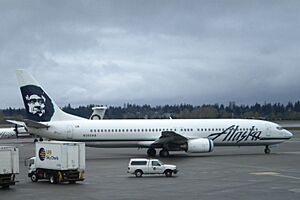
With new Boeing 737 Next Generation planes arriving in 1999, Alaska started more medium-distance flights. In 2000, Alaska began flying between Anchorage and Chicago.
In May 2001, the airline received its first 737-900. In 2001, the airline was allowed to fly nonstop from Ronald Reagan Washington National Airport to Seattle. However, this was stopped after only a week due to the September 11 attacks. The airline restarted service to Reagan Airport on December 4, 2001.
In January 2002, William Ayer became CEO of Alaska Airlines. He led a big change called Alaska 2010. This plan aimed to protect the airline from the ups and downs of the airline industry.
In 2003, Alaska Airlines won an award for its new technologies. These technologies were used both in the airport and on the planes.
In 2005, Alaska Airlines decided to stop using its 26 MD-80 planes. This was because the Boeing 737 Next Generation planes were more efficient. Also, maintenance, fuel, and training costs for the MD-80s were rising. The last MD-80 flights happened in August 2008. To show its move to an all-Boeing fleet, Alaska Airlines painted a 737-800 called Spirit of Seattle.
Also in 2005, Alaska Airlines hired other companies to do many jobs, like ground crew work. This included Menzies Aviation. This led to lower wages for some workers.
Starting in June 2006, Alaska Airlines added new cargo planes. These included five 737-400C combi aircraft and one 737-400F freighter. The "combi" planes were special because they could carry both cargo and 72 passengers. This was useful for transporting goods and people to remote towns.
2010s
In March 2010, Alaska Airlines started flying from San Jose, California, to Kahului and Kona, Hawaii. They also began flights from Sacramento, California, to Kahului, Hawaii.
In September 2010, Alaska Airlines began service between Seattle and Lambert-St. Louis International Airport.
In 2011, Horizon Air changed how it operated. It started flying planes for Alaska Airlines under a special agreement. All Horizon planes were repainted with an "Alaska Horizon" design.
Alaska Airlines also made a similar agreement with SkyWest Airlines. Starting in May 2011, SkyWest began flying some routes for Alaska under the name "Alaska SkyWest."
In January 2011, Alaska Airlines ordered thirteen Boeing 737-900ERs. They also ordered two 737-800s.

In 2011, Alaska Airlines worked with Boeing and Fujitsu to use a new technology. This technology helps mechanics check plane parts faster. Mechanics can point a device at small RFID tags on parts. This shows when parts were last replaced.
In mid-2011, the airline gave iPads to its pilots. This replaced 25 pounds of paper flight manuals. Alaska Airlines was the first major airline to use iPads for flights.
In November 2011, Alaska Airlines flew 75 commercial passenger flights using biofuel. This fuel was made from used cooking oil.
On February 16, 2012, Alaska Airlines' CEO, Bill Ayer, retired. Brad Tilden became the new CEO on May 15, 2012.
In March 2012, Alaska Airlines started flying from Seattle to Kansas City. In June 2012, they began service to Philadelphia. Flights from Seattle-Tacoma to Miami International Airport ended in July 2012. Service to nearby Fort Lauderdale began on July 16. Service to San Antonio began in September 2012. Alaska Airlines began service from San Diego to Orlando in October 2012.
In October 2012, Alaska placed its largest order ever. It ordered 50 Boeing 737s. This included 20 737 MAX 8s, 17 737 MAX 9s, and 13 737-900ERs.
In June 2013, Alaska Airlines announced a plan to replace Boeing 737s on flights between Fairbanks and Anchorage with Bombardier Q400s. These planes would be flown by Horizon Air. This plan aimed to lower costs and fares. Some people in Fairbanks were worried about the safety of the Q400s and boarding outside in the cold. Alaska Airlines changed a jetway at Fairbanks International Airport so passengers would not have to go outside. In November 2017, Alaska announced it would go back to using only jets in Alaska.
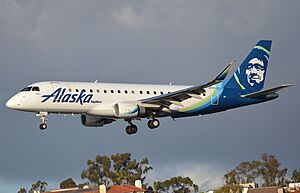
New nonstop flights from Seattle to Salt Lake City began in 2013. Flights to Albuquerque, Baltimore, Detroit, New Orleans, Tampa, and Cancun all began in 2014.
In 2015, Alaska Airlines announced three new nonstop flights from Seattle. These were to Charleston, Nashville, and Raleigh-Durham. These flights began in late 2015.
In January 2016, Alaska Airlines showed a big update to its brand. This included a new logo and plane design. The Alaska name was made simpler. The Eskimo logo was also simplified and made more colorful.
In 2017, Alaska Airlines expanded to Indianapolis. They started nonstop service to Seattle in May and San Francisco in September. The San Francisco route was stopped in September 2018.
In September 2018, Alaska Airlines added nonstop service from Seattle to Pittsburgh.
Buying Virgin America
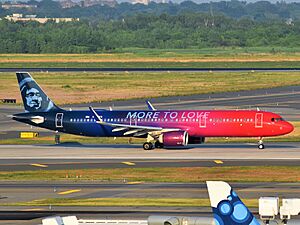
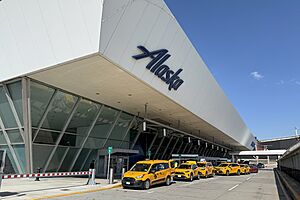
Virgin America was an airline based in the San Francisco Bay Area. It started in 2005 and quickly became popular. Virgin's owners wanted to get their money back quickly. So, they made the airline public, selling shares on Nasdaq in November 2014. The airline's stock price went up.
Soon after, JetBlue wanted to buy Virgin America. Alaska Airlines saw buying Virgin America as a way to grow in California and on the West Coast. Richard Branson, a founder of Virgin America, was sad about the sale. However, most of Virgin America's shareholders voted to approve the sale to Alaska Air Group. Alaska offered more money than JetBlue.
Alaska Air Group bought Virgin America for $2.6 billion. The total cost, including other expenses, was about $4 billion. The purchase was completed on December 14, 2016.
The U.S. Department of Transportation gave a single operating license for both airlines in January 2018. The airlines combined their passenger systems in April 2018. This meant that most customer services, like flight numbers and websites, used only the Alaska Airlines brand. Virgin America's last flight was in April 2018. The last Virgin America plane was repainted in June 2019.
This purchase created a challenge. Alaska Airlines uses only Boeing 737 planes. But Virgin America used only Airbus planes. Even though both types of planes are for similar flights, they are very different to operate. Pilots need long training to switch between them. This is expensive for the airline. The first Airbus leases ended in 2019. In April 2020, Alaska stopped using 19 planes it got from Virgin America. Many Airbus pilots were retrained to fly Boeing 737s.
2020s
Due to the COVID-19 pandemic, Alaska Airlines announced it would reduce its number of employees by 30%. By the end of 2020, about 7,000 jobs were cut.
In February 2020, Alaska Airlines announced it planned to join the Oneworld airline alliance. On March 31, 2021, Alaska Airlines officially joined Oneworld. This added seven new airline partners.
In December 2020, Alaska Airlines agreed to buy 23 Boeing 737 MAX 9 jets.
In November 2021, Alaska Airlines started seasonal flights to Belize. This made it the fourth foreign country served by the airline.
In August 2022, Alaska Airlines invested in Twelve. This company makes sustainable aviation fuel (SAF) from carbon dioxide. This fuel would have much lower emissions.
In October 2022, Alaska Airlines announced a deal with Boeing to buy 52 more Boeing 737 MAX planes. This was the airline's largest plane order so far.
In May 2022, Alaska Airlines stopped printing its inflight magazine. They moved to an online blog instead. This was due to COVID-19 cleaning rules.
In January 2023, Alaska Airlines announced it stopped using plastic cups on its flights. It was the first U.S. airline to do so. This is part of a plan to replace its top five waste-producing items by 2025.
In 2023, Alaska Airlines partnered with Taiwan-based Starlux Airlines. Mokulele Airlines and its parent company, Southern Airways Express, also became partners in 2023. Porter Airlines, a Canadian airline, became a partner. A partnership with Kenmore Air was restarted in 2023.
Alaska Airlines announced nonstop flights to Guatemala and the Bahamas in June and July 2023. Bahamasair was announced as a partner airline at the same time.
In 2023, Alaska Airlines settled a lawsuit. The lawsuit claimed the airline did not pay certain workers correctly.
On April 17, 2024, the FAA issued a ground stop for Alaska Airlines. This stopped all of the airline's flights. The FAA did not say why.
Buying Hawaiian Airlines
In December 2023, Alaska Airlines announced it would merge with Hawaiian Airlines. The deal was worth $1.9 billion in cash. It also included taking on about $900 million in debt. Experts had suggested this merger for years. It would create a combined airline focused on the western United States. Alaska, which mainly flies within the U.S. with smaller planes, would gain Hawaiian's larger jets and international routes.
The merger kept both Alaska Airlines and Hawaiian Airlines as separate brands. Hawaiian Airlines also became a Oneworld member. The two airlines plan to combine their frequent-flyer programs. Alaska's Mileage Plan will likely replace HawaiianMiles. Hawaiian Airlines shareholders approved the merger in April 2024.
The U.S. Department of Justice completed its review of the merger on August 19, 2024. It decided not to block the merger in court. The merger then needed approval from the U.S. Department of Transportation.
The companies said they had very few overlapping routes. Alaska Airlines highlighted its experience flying within Alaska. It promised to keep many flights between Hawaii's islands. The Wall Street Journal thought the merger might lead to higher prices for flights to Hawaii. However, the companies disagreed.
When the merger was announced, Hawaii's Governor Josh Green said he would watch it closely. He wanted to make sure Hawaii's needs were met and workers were cared for. Alaska Airlines made three promises to Hawaii residents. They promised to keep the Hawaiian Airlines brand, keep all union employees, and protect interisland flights. In February 2024, mayors from Hawaii's counties supported the merger. They said it was "good for Hawaiʻi."
Alaska Airlines confirmed that miles from Hawaiian's HawaiianMiles program would be changed to Alaska Airlines Mileage Plan miles at a 1:1 rate.
In August 2024, the review period ended without problems. Alaska called this a "significant milestone." On September 17, 2024, the U.S. Department of Transportation approved the merger. This was the final step. The merger was completed on September 18, 2024. Both airlines promised to keep key routes in Hawaii and protect customers for six years.
Where Alaska Airlines Flies
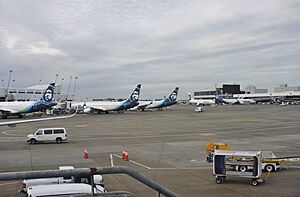
Alaska Airlines flies to more than 115 places. These include cities in the United States, Bahamas, Belize, Canada, Costa Rica, Guatemala, Japan, and Mexico. Some places in Alaska it serves are Anchorage, Fairbanks, Juneau, and Sitka. Many of these places cannot be reached by road.
The airline started flying to the Russian Far East in 1991. This was after the Soviet Union broke up. But they stopped this service in 1998 due to money problems in Russia.
Alaska has always been one of the biggest airlines on the West Coast of the United States. It has a strong presence in Anchorage, Seattle, Portland, and San Diego. It also serves four airports in the Bay Area and four in the Los Angeles area.
Some cities with less air traffic are served by regional airline partners. These partners fly and maintain planes for Alaska Airlines. Alaska's partners include its own regional airline, Horizon Air, and SkyWest Airlines.
Alaska Air Group started its first modern long-distance international flight between Seattle and Tokyo/Narita on May 12, 2025. It uses Hawaiian Airlines' larger Airbus A330-200 planes because Hawaiian merged with Alaska Air Group. A Seattle–Seoul/Incheon route is planned for September. Ten more routes are planned by 2030.
Partner Airlines
Alaska Airlines is part of the Oneworld alliance. It also has partnerships with other airlines. This means you can often earn or use miles on these airlines.
- Aer Lingus
- Air Tahiti Nui
- Aleutian Airways
- American Airlines
- Bahamasair
- British Airways
- Cape Air
- Cathay Pacific
- Condor
- Contour Airlines
- Fiji Airways
- Finnair
- Hainan Airlines
- Hawaiian Airlines
- Iberia
- Icelandair
- Japan Airlines
- Kenmore Air
- Korean Air
- LATAM Chile
- Level
- Malaysia Airlines
- Mokulele Airlines
- Oman Air
- Philippine Airlines
- Porter Airlines
- Qantas
- Qatar Airways
- Royal Air Maroc
- Royal Jordanian
- Singapore Airlines
- Southern Airways Express
- SriLankan Airlines
- Starlux Airlines
Connecting Flights with Other Airlines
Alaska Airlines has agreements with these airlines for connecting flights:
- Air India
- Air Premia
- Azores Airlines
- Caribbean Airlines
- Emirates
- French Bee
- Hahn Air
- Play
- Norse Atlantic
- WestJet
Planes Alaska Airlines Uses
Services on Board
Cabin Classes
First Class offers early boarding, free food, and drinks (both alcoholic and non-alcoholic). The seats are wider and recline. They are arranged 2-2 on main planes and 2-1 on smaller regional jets. All First Class seats have power outlets.
Premium Class is located behind First Class. These seats have 4 more inches of legroom than regular economy seats. Passengers get early boarding and free alcoholic or non-alcoholic drinks. A small snack is included, and more food can be bought. Premium Class seats can be chosen when booking. Elite members of Alaska's Mileage Plan program can also get free upgrades. All Premium Class seats on main planes have USB and power outlets.
Main Cabin is Alaska's economy class. Main Cabin passengers get a free non-alcoholic drink and a small snack. Food and alcoholic drinks can be bought. All Main Cabin seats on main planes have USB and power outlets.
In-flight Entertainment and Food
Food and Drinks
In 2006, the airline started selling meals on most flights longer than 2.5 hours. They offer "Picnic Packs" for a fee in Premium Class and Main Cabin. These packs include products from West Coast companies.
In February 2012, Alaska Airlines started serving coffee from Starbucks on all its flights. Before this, Starbucks coffee was only on Horizon Air flights. Horizon Air was the first airline to serve Starbucks coffee in 1990. In 2023, Alaska switched to serving coffee from Stumptown Coffee Roasters.
In July 2018, Alaska Airlines updated its First Class menu. New items included ice cream, brownies, and pasta. Passengers could also order food before flights.
Internet and Entertainment
All Alaska Airlines jets have Wi-Fi and streaming entertainment. Internet access costs a flat $8 per flight on satellite Wi-Fi planes. On older systems, internet costs depend on flight length. Streaming entertainment and messaging services are free.
Alaska started testing in-flight Wi-Fi in 2009. They chose the Gogo Inflight Internet system in February 2010. In October 2010, flights between Anchorage and Fairbanks were the first to get Wi-Fi. The system was later expanded to all routes, except Hawaii. Alaska Airlines began switching to a satellite-based system in 2019. This system works on all flights, including those over oceans.
Reward Programs
Mileage Plan
The frequent-flyer program for Alaska Airlines and Horizon Air is called Mileage Plan. This program partners with airlines from all three major airline alliances (Oneworld, SkyTeam, and Star Alliance), plus other airlines. There is no fee to join Mileage Plan. Miles do not expire. The program has special levels (MVP, MVP Gold, MVP Gold 75K, and MVP Gold 100k) for people who fly often. These levels offer more travel benefits.
Club 49
In November 2011, Alaska Airlines started a new program called Club 49. It is only for Mileage Plan members who live in Alaska. Benefits include free checked bags and emails about flight sales. There is no fee to join, and memberships are good for one year.
Alaska Lounge
The airline has nine Alaska Lounges. Seattle–Tacoma International Airport, Alaska's biggest hub, has three. Portland International Airport has two. Ted Stevens Anchorage International Airport, San Francisco International Airport, New York JFK, and Los Angeles International Airport each have one. Passengers can also use Oneworld lounges.
Company Information
Alaska Air Cargo
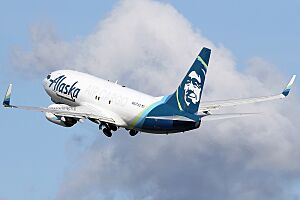
Alaska Air Cargo handles cargo in parts of the United States. It has the largest air cargo operations on the U.S. West Coast among passenger airlines. Alaska's cargo flights mainly go between the northwestern states and Alaska, especially between Anchorage and Seattle. South of Alaska, they mostly carry fresh Alaskan seafood. Cargo going north from Seattle is mainly mail for the U.S. Postal Service. The airline carries goods for remote Alaskan communities and personal packages.
Helping Communities
The Alaska Airlines Foundation gives money to non-profit organizations. These are charities in Alaska and Washington.
Working with Employees
Alaska's pilots are part of the Air Line Pilots Association, International. Its flight attendants are part of the Association of Flight Attendants.
Since May 2005, the airline has hired other companies to handle baggage. This was after a union agreement was rejected. It saved the airline about $13 million a year. In late 2016, Alaska Airlines created its own company, McGee Air Services. This company also competes for ground handling jobs in some Alaska cities.
Plane Incidents
Alaska Airlines has had 11 major plane incidents. Nine of these resulted in deaths. The other two caused damage to the plane but no deaths. A total of 226 passengers and crew, plus two people on the ground, have died.
- On November 30, 1947, Flight 009, a Douglas C-54A, crashed while trying to land at Seattle–Tacoma International Airport. The plane went off the runway and hit a car. Eight people on the plane died, plus the car driver. This was due to pilot error.
- On January 20, 1949, Flight 8, a Douglas C-47A, hit the side of a mountain near Kenai, Alaska. Five of the six people on board died. The pilot flew off the planned path.
- On August 8, 1954, an Alaska Airlines C-47A crashed into a mountain near McGrath, Alaska. Both pilots died.
- On March 2, 1957, Flight 100, a Douglas C-54B, hit a mountain near Blyn while approaching Seattle. All five people on board died. The pilot flew into bad weather and made a navigation mistake.
- On July 21, 1961, Flight 779, a Douglas DC-6A, crashed short of the runway. All six crew members died. The runway lights were off, and the control tower did not tell the pilots.
- On April 17, 1967, an Alaska Airlines Lockheed L-1049H landed with its landing gear up during heavy snow at Kotzebue Airport. Everyone survived, but the plane was too damaged to fix.
- On September 4, 1971, Flight 1866, a Boeing 727-193, crashed into a mountain near Juneau. All 111 people on board died. This was due to misleading navigation information and the crew not using all available tools.
- On April 5, 1976, Flight 60, a Boeing 727-81, went off the runway while landing in Ketchikan. One passenger died. The pilot tried to take off again too late.
- On June 9, 1987, an Alaska Airlines Boeing 727-90C at Anchorage International Airport hit a jetway while moving and caught fire. The plane was destroyed.
- On March 13, 1990, a Boeing 727 taking off from Phoenix Sky Harbor International Airport hit and killed a man who ran onto the runway. No one on the plane was hurt.
- On January 31, 2000, Flight 261, a McDonnell Douglas MD-83, crashed into the Pacific Ocean near Anacapa Island. All 88 people on board died. The cause was a part that failed due to not enough lubrication. This led to stricter checks on airline maintenance.
- On December 26, 2005, Alaska Airlines Flight 536, a McDonnell Douglas MD-83, had a hole appear in its side at 26,000 feet. The pilots landed safely. Investigations showed the hole was likely caused by a baggage-handling vehicle hitting the plane before takeoff.
- On November 14, 2020, Flight 66, a Boeing 737-700, hit and killed a brown bear while landing at the Yakutat Airport in Alaska.
- On August 20, 2023, Flight 1288, a Boeing 737-800, had a part of its landing gear break at John Wayne Airport. This caused the landing gear to go into the plane's wing.
- On January 5, 2024, Flight 1282, a Boeing 737 MAX 9, had a part of its side (a plugged exit door) come off shortly after taking off from Portland International Airport. The flight returned to Portland. No one died, but some minor injuries were reported. The plane's maker, Boeing, took responsibility.
Employee Incidents
- On September 2, 2019, an Alaska Airlines flight attendant caused panic at Newark Liberty International Airport by calling for an evacuation. Police found it was a false alarm. The employee was dealing with a mental health issue.
- On October 22, 2023, an off-duty Alaska Airlines pilot reportedly tried to shut down the engines of Horizon Air Flight 2059. Crew members stopped him. The plane landed safely at Portland International Airport. The pilot was charged with many counts of attempted murder. Passengers from the flight have sued Alaska Airlines and Horizon Air. They want to know more and for airlines to check staff mental health better.
See also
 In Spanish: Alaska Airlines para niños
In Spanish: Alaska Airlines para niños
- List of airlines of Alaska
- Air transportation in the United States


